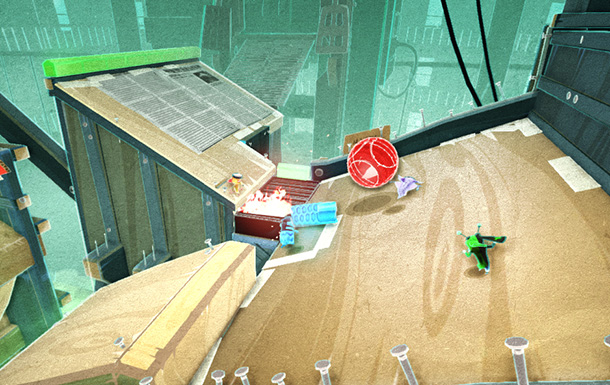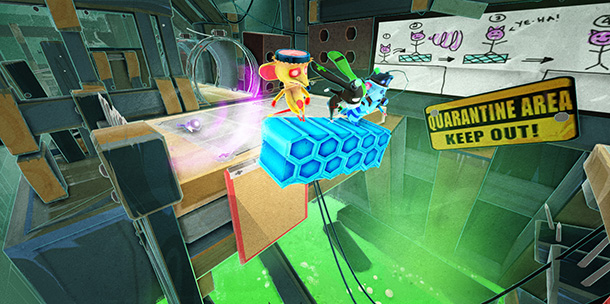
It’s always the last place you’d look, isn’t it?
Tucked away in the corner of the farthest reaches of E3’s mega halls was a diminutive booth owned by Spearhead Games. Much like the small booths at expos like PAX or ComicCon, Spearhead couldn’t compete with the scale or flash of companies like Ubisoft or EA. With mega games like Assassin’s Creed IV and Final Fantasy XV just around the corner, what they showcased managed to trump the majority of much else that I saw at the show.
Perhaps that’s why the premise behind the company’s Tiny Brains works so well: small sizes can have big ideas, and can sometimes even lead to amazing things.
As I sat down to play, holding a PS4 controller in hand (LED color tuned to my character choice) while three other strangers plopped down on the sofa next to me, I initially didn’t know what to expect from the game or my team. What happened was a quirky, almost bond-creating experience.

If I were to describe the game’s genre in any way, it’d be to call it “Social Puzzle Solving”. In simplicity, it involves four people working together to solve puzzles and exit rooms on their way to the next. Based in an isometric viewpoint, the characters on the screen — lab animals of different types and special powers — bump into each other, knock each other into pitfalls, and sometimes work together to solve the puzzle at hand.
That’s the easy explanation. What the game actually creates is an incredibly social experience predicated on trial and error and communication.
Each character has a specific ability that can be used to resolve the room’s puzzles. One of the rodents can create create a block of ice, another can switch places with objects across the room. The third can force-push objects away from it, and the final (the one that I chose) can attract objects towards it. As the levels unfolded, we spent time learning to use our abilities in the initial rooms. I pulled blocks or items towards me to reach ledges, or I would accidentally knock one of my partners into a meat grinder. “Oops! Sorry!” I’d shout out, as I giggled and ran around the room trying to make my way to the top. Eventually, as accidents occur, I learned to pull my partner’s ice blocks to me, or pull them across a room after another teammate teleported it over to another side.
[pullquote_right]Tiny Brains has the potential to really become a special social experience.[/pullquote_right]
“Oh, over there! Push it over there and I’ll pull it to the other side!”
As the shouts began to get louder, and our fingers would point to the screen (or use the PS4 touch pad to highlight things), we learned to cooperate and chain our powers together. We still knocked each other into voids, but when we it happened we weren’t frustrated. We would laugh, we would shake our heads, we would yell “Crap, sorry!” and we would continue. We would eventually become completely in tune with each other, just a few puzzles in, and worked together in ways that reminded me of some of my favorite Mario Party experiences of the past.
I left my demo not only shaking hands with the people I played with, but exchanging business cards and walking together to our next appointments, smiling and reminiscing about some of the accidents that had just taken place. Tiny Brains has the potential to really become a special social experience. It’s smart, it has great puzzles, and it allows us to turn to the people next to us and smile. I haven’t seen many recent multiplayer games do that this well. It’s not about competition or cooperation, it’s about friendship.
And about mice with crazy brain gears.
Tiny Brains arrives this Fall to PSN, Steam, and possibly XBLA. It will be available on the PS4 during the console launch window.


No Comments